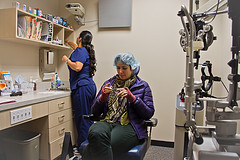 Nearsighted farsighted persons have eye defects that vary. When a person is unable to see properly things that are at a distance, they are nearsighted. When one is unable to see clearly things nearby, they are said to be farsighted. The nearsighted farsighted visions both require remedies and treatments to reduce or even eradicate the symptoms.
Nearsighted farsighted persons have eye defects that vary. When a person is unable to see properly things that are at a distance, they are nearsighted. When one is unable to see clearly things nearby, they are said to be farsighted. The nearsighted farsighted visions both require remedies and treatments to reduce or even eradicate the symptoms.
In nearsightedness or myopia, the vision is good up close compared to at a distance. Farsightedness or hyperopia is where the vision is better at a distance compared to up close. These conditions are caused by structural distortions in the eye. Nearsighted symptoms may include squinting, blurred vision of objects at a distance, eyestrain and headaches. Farsighted symptoms include the need for more light when working, blurred vision of close objects, headaches and eye fatigue.
Treatment for both conditions includes eyeglasses and wearing soft contact lenses. There is also a LASIK or Laser in situkeratomileusis that permanently reshape the cornea by etching away the cells found beneath the surface. The Epi LASIK method is a hybrid process that combines elements of LASEK and LASIK. PRK or Photorefractive keratectomy is the use of laser to reshape the cornea permanently by removing cells on the surface.